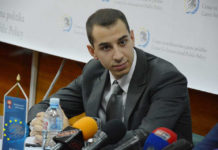Can you tell us more about yourself and mention some of the main projects that your laboratory is currently working on?
My name is Tomas Morosinotto, I am a professor of plant physiology at the University of Padua.
The main project we work in the lab concerns photosynthesis. We are trying to understand better how the reaction of photosynthesis works and to improve it. Our goal is to make plants more efficient in making more biomass and fixing CO2 which is an important issue now that we are dealing with an increase of CO2 into the atmosphere.
The other important project is developing the possibility of producing biomass from algae. The idea here is that in order to make more biomass and to fix more CO2 from the atmosphere, we want to use other organisms. We are still using plants, but we will have other organisms to produce more biomass and fix more CO2.
What is the main issue that agriculture faces within the 21st century? What would be its potential threats and why?
One of the challenges is that the human population is increasing quite fast. We expect to have around 10-11 billions of people by the end of this century and the first challenge is to feed all these people. The food production that we have at the moment is not going to be enough.
The approaches that we have used until now for improving plants productivity have been very successful in the past decades but are sort of saturating. We think that by improving photosynthesis we will be able to improve plants productivity in next decades, that is the focus of our lab.
Another big challenge is that the agriculture as it is now is not very environmentally friendly. Agriculture is not a natural activity. There is a big contribution to human CO2 emission that comes from food production (around 10% in Europe). We need to improve the agricultural productivity but at the same time we need to make it better, without producing so much CO2.
Extending the cultivating area is one of the reasons why agriculture has such a negative impact on the carbon balance. If we cut down forests to cultivate crops, all the carbon that was stored in the forest is going to be released into the atmosphere. Putting simply, this is the reason why we need to keep the cultivated area as it is or even reduce it and try to improve its productivity if we want to face the climate change.
How can a modern man as an individual contribute to the suppression of climate change? Do you find that it is too late for taking any measures?
One important lesson that we learned during Covid time is that transportation is not the major contributor to the CO2 emissions. If we all go by walking or by bike, the climate change will not be stopped unfortunately. Using less fossil fuel will help of course, but even if we stopped travelling completely, we are not going to stop the CO2 emissions.
If we want to do something, the individual contribution is on what we buy and what we consume. One thing we can do individually is that we should pay attention to how much waste we generate.
The issue is that this problem is very complex. It is very complicated to the individual to combat it. We need to really change everything, every our activity needs to be changed and modified to take into account climate change.
It is not too late. There is still time for reducing some impact. For sure it is too late to avoid the climate change completely, but it is not too late to reduce the most negative effect. How seriously this is going to be depends on the next decades.
When it comes to alternative energy sources, what potential roles can plant have in this aspect?
What is clear is that we can use plant biomass to make energy. We can make bioethanol, biodiesel or biogas. This is possible. The issue is that we already need this biomass for food. If we are going to have 4 extra billion people to feed, then we will need more biomass for food and not for producing energy.
Are we going to have enough biomass to also supply some energy? It depends on how much biomass we are going to be able to produce in the next decades. This is a big question that has no sure answer in my opinion. What is clear is that we can make energy from plants, but how much we can produce depends on how much people we have to feed, how much energy we need etc. Plants can play a role as an energy source for sure but how much we don’t know yet.
One another problem we are facing is plastic pollution, how can plants contribute to the reduction of plastic waste on Earth?
For plastic pollution there are 2 things: how we produce plastic masses and how degradable they are.
Now we are producing plastics from fossil fuels. We are emitting CO2 to produce it. Plants and also algae, cyanobacteria and other microorganisms are very interesting for that purpose. We can use their biomass to make plastics instead from fossil fuels. This is one way to contribute to CO2 emissions. We can also use plants and other photosynthetic organisms to produce plastics that can be degraded or that is not long-lasting like plastics that we normally produce.
It is important to bear in mind that bioplastic is not necessarily biodegradable. Producing bioplastic that is not biodegradable is not the complete solution of the issue. We should find a new strategy to degrade the plastics, to make it biodegradable.
There is a lot of research on plastic that is both biodegradable and bioproduced. For instance, we just started a new European project in the lab to produce bioplastics from cyanobacteria to use waste CO2 to produce bioplastics.
You have mentioned once that there are photobioreactors installed on the top of the building of the biological department in the University of Padua, for the use of algae biomass production. Would you like to explain to us how can urban areas be used for growing plants and algae, what benefits would we gain from it?
The reason why we installed them on top of the building instead on other areas is that we don’t want to increase the cultivated area in the field. The idea is that all the area that is suitable for cultivating crops should remain used for crops, to make food. We should not expand that area any more. Instead what we can do is that we have a lot of other areas that are not used for cultivation, like cities or areas that are not suitable for cultivation, for example slopes. In all these areas where it is not convenient to cultivate crops we can in principal cultivate algae. If we install photobioreactor on the top of the building, the building can become CO2 fixation spot. At the end, we are going to increase the ability to produce biomass and fix CO2. The idea is to have urban areas that are not used for plants cultivation, they can become CO2 fixation points.
In principle we can do the same with plants. But in that case, it is not so much to produce biomass but to reduce the environmental impact of the building. In the botanical garden in Padua we have this garden on the top of the building and it is very useful. We are spending less energy for climate control of the building. In the summer the plants use water and have some evaporation, which helps to lower the temperature of the building few degrees.
Having taken into consideration the current situation in Serbia, would you like to share with us your thoughts from the scientific point of view on both positive and negative impacts on lithium extraction and how do companies that are doing so affect the environment?
When we use renewable sources for electricity, like solar or wind power, these are sources of energy that produce electricity that can’t be stored, you either consume it immediately or it is lost. That’s why batteries are so important, because we need to find ways to store this electricity that we are producing.
Another thing is that with the present technology lithium batteries are not good enough for really solving this problem. We need better technologies for batteries. For example, cars that run on electricity have a huge amount of weight in their batteries because the technology is not good enough. Having 400-500 kilograms of the batteries in the cars is really a huge amount of weigh that we are travelling around with. In that sense, biomass and biofuels will be much better because with the same amount of energy is stored in much less weight.
Lithium is not a long term solution of the problem. We need to find new chemical batteries that are better than the lithium ones that we are using now.
Lastly, what is the future of agriculture, what would you suggest that we as people should turn towards?
We need to be more aware of what the negative impacts of agriculture are. Agriculture is not a natural activity. If we look at the cultivated field, it is not a natural environment at all. It is outside, but it is very influenced by the human activities. The plants we are cultivating are the result of thousands of years of selection. They are not natural at all and they will never be found in nature.
If we really want to feed billions of people we need to find agriculture that is even more influenced by the human activities, not less. The idea of organic agriculture as a better alternative is very silly, it can be better for few people but not for 10 billion people. The future of agriculture is to be even better in what we are trying to do now –to make plants more productive and also become smarter in reducing the CO2 emissions and the negative impact we are generating by using agriculture.
There is a new technology on the genome editing that is now a reality. It should be allowed in Europe in the next years. The trend is quite clear on that. The plants obtained in that way will not be considered as genetically modified organisms, they will be named somehow differently and they will become a part of the reality slowly without too much resistance, I hope.
Cover Photo: Center for International Public Policy (All rights reserved)











